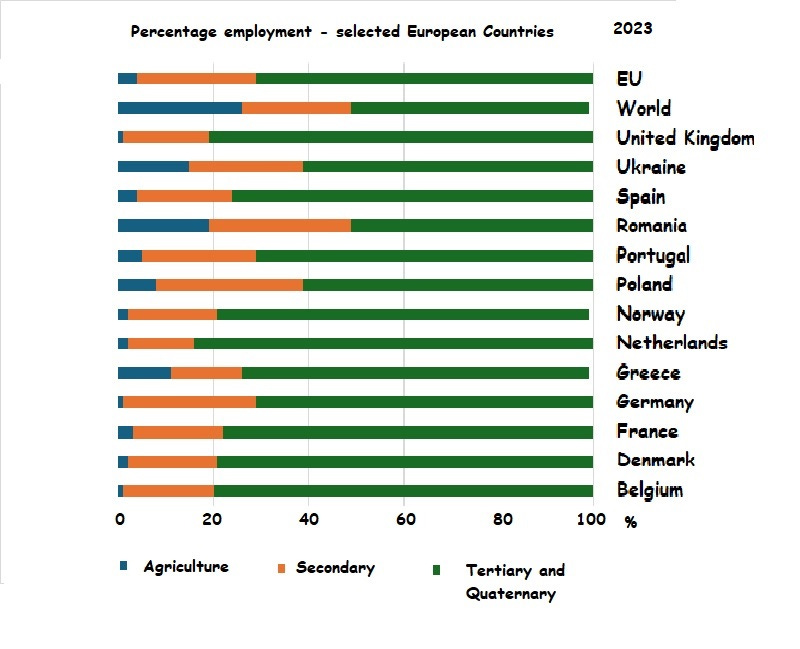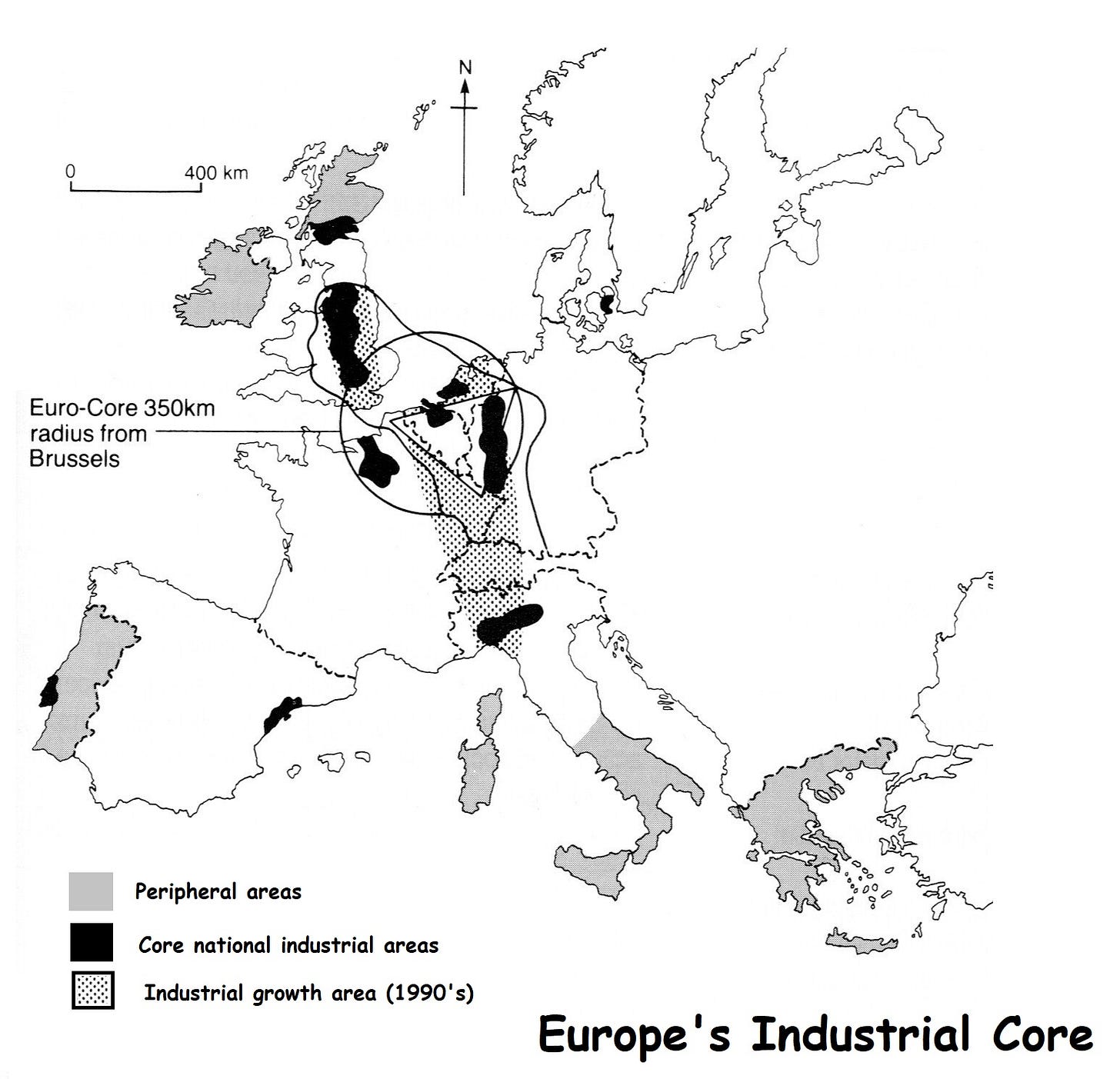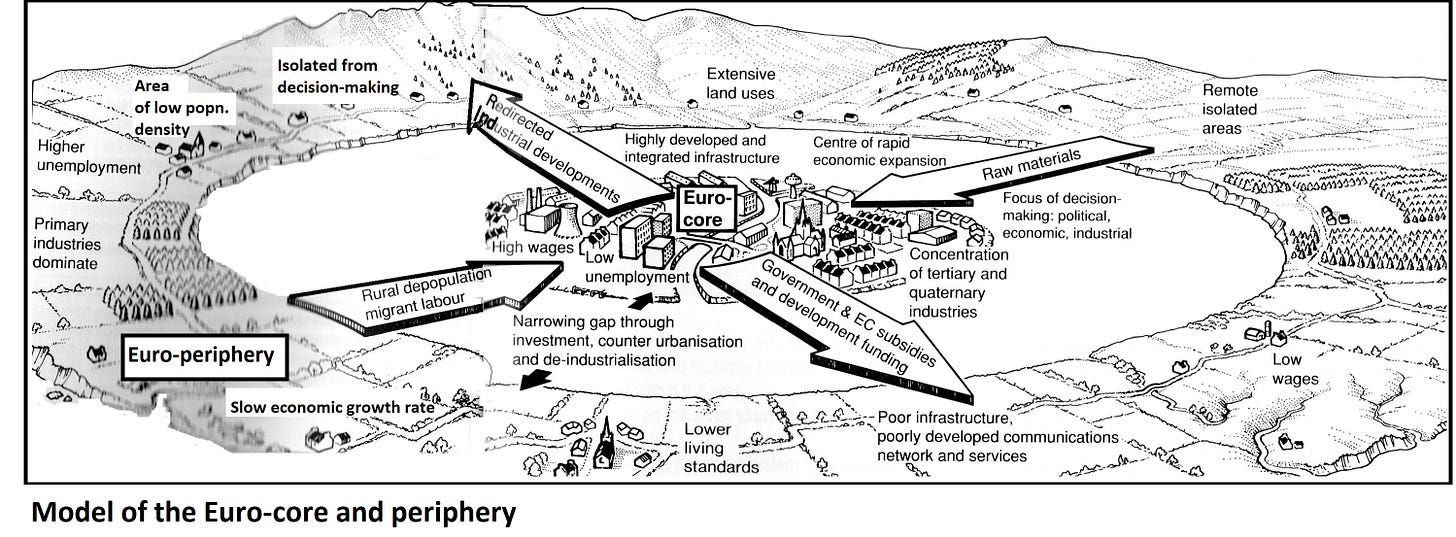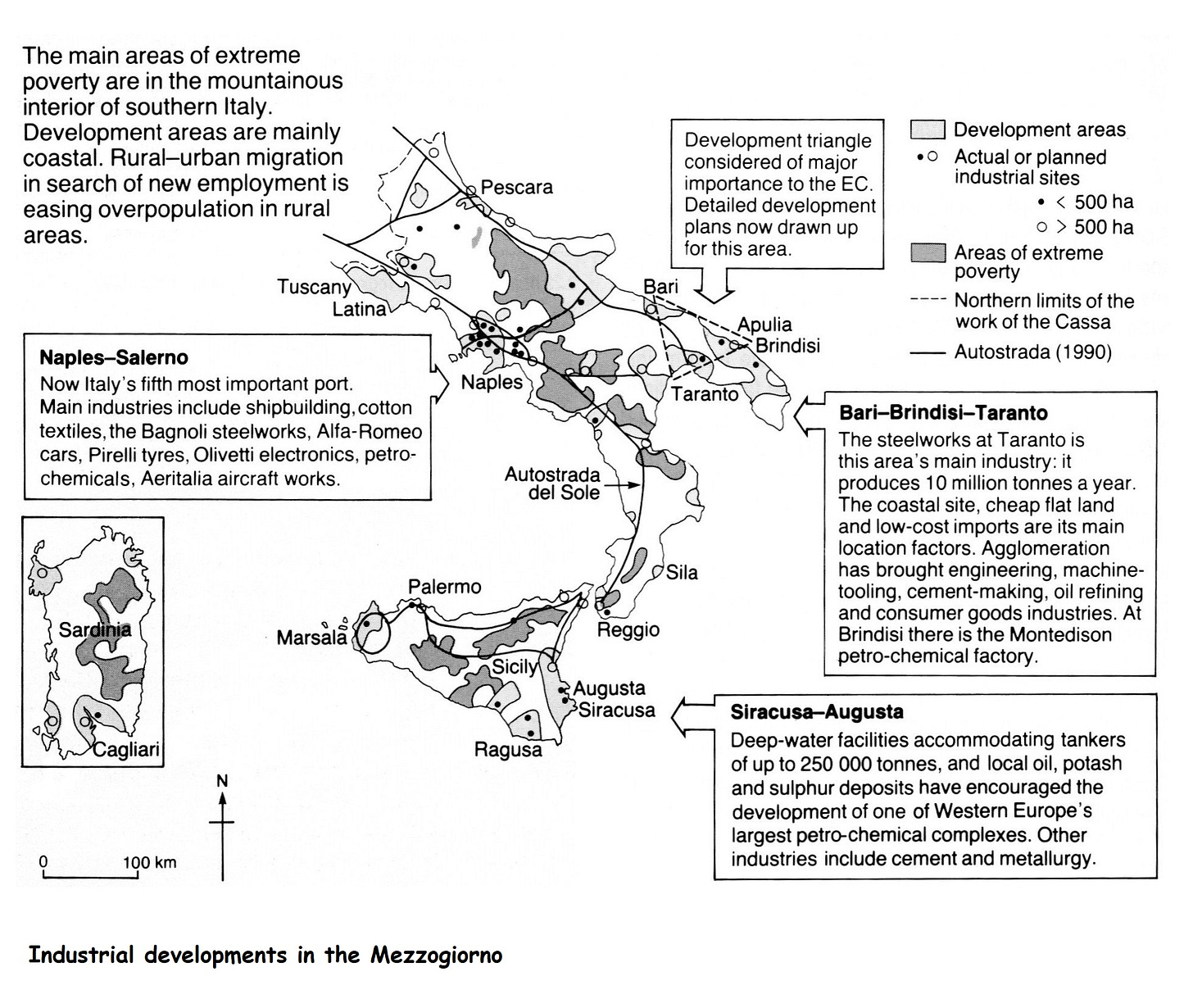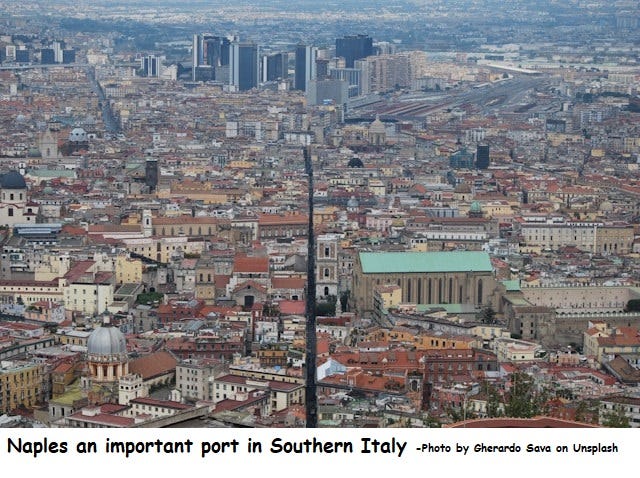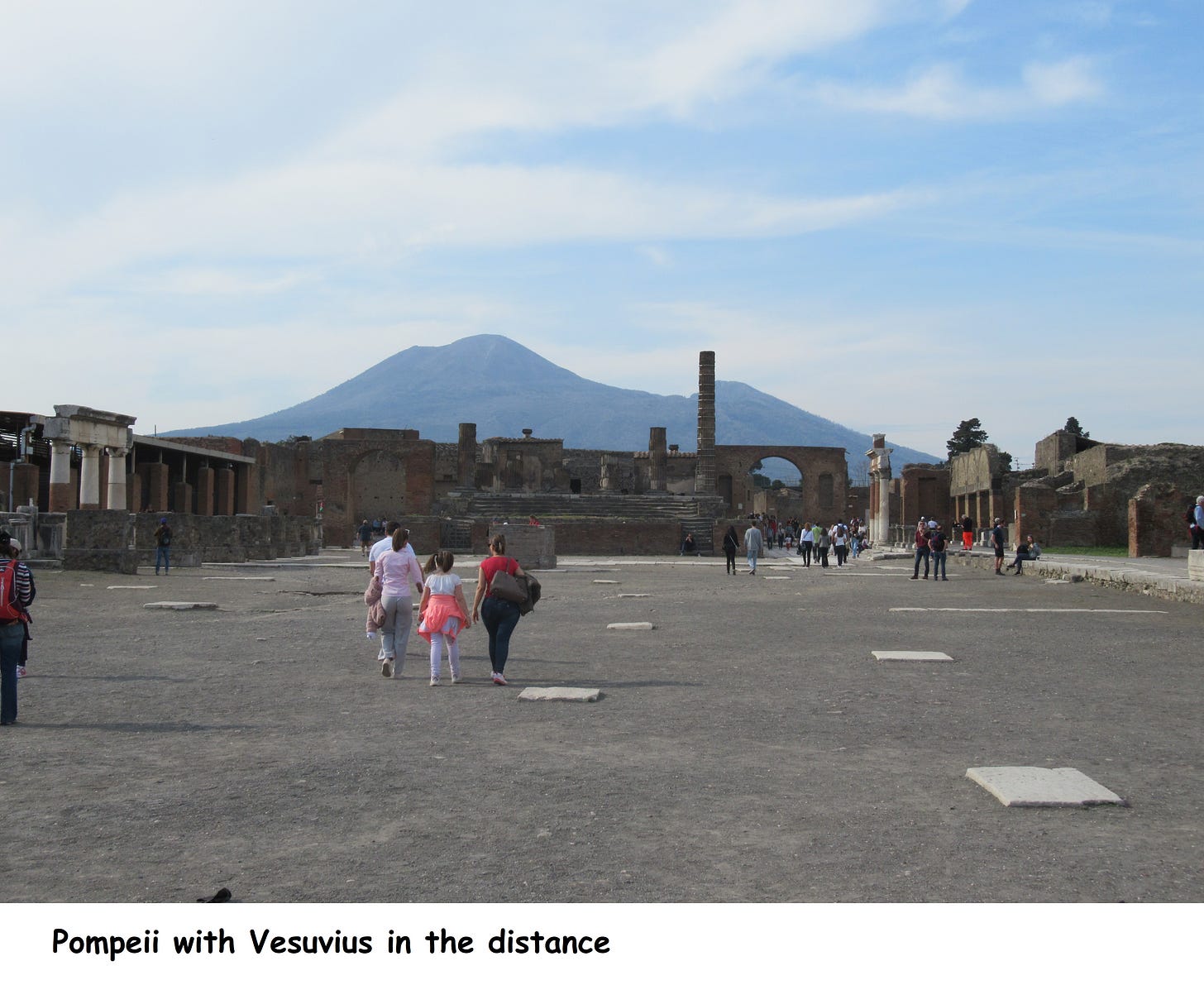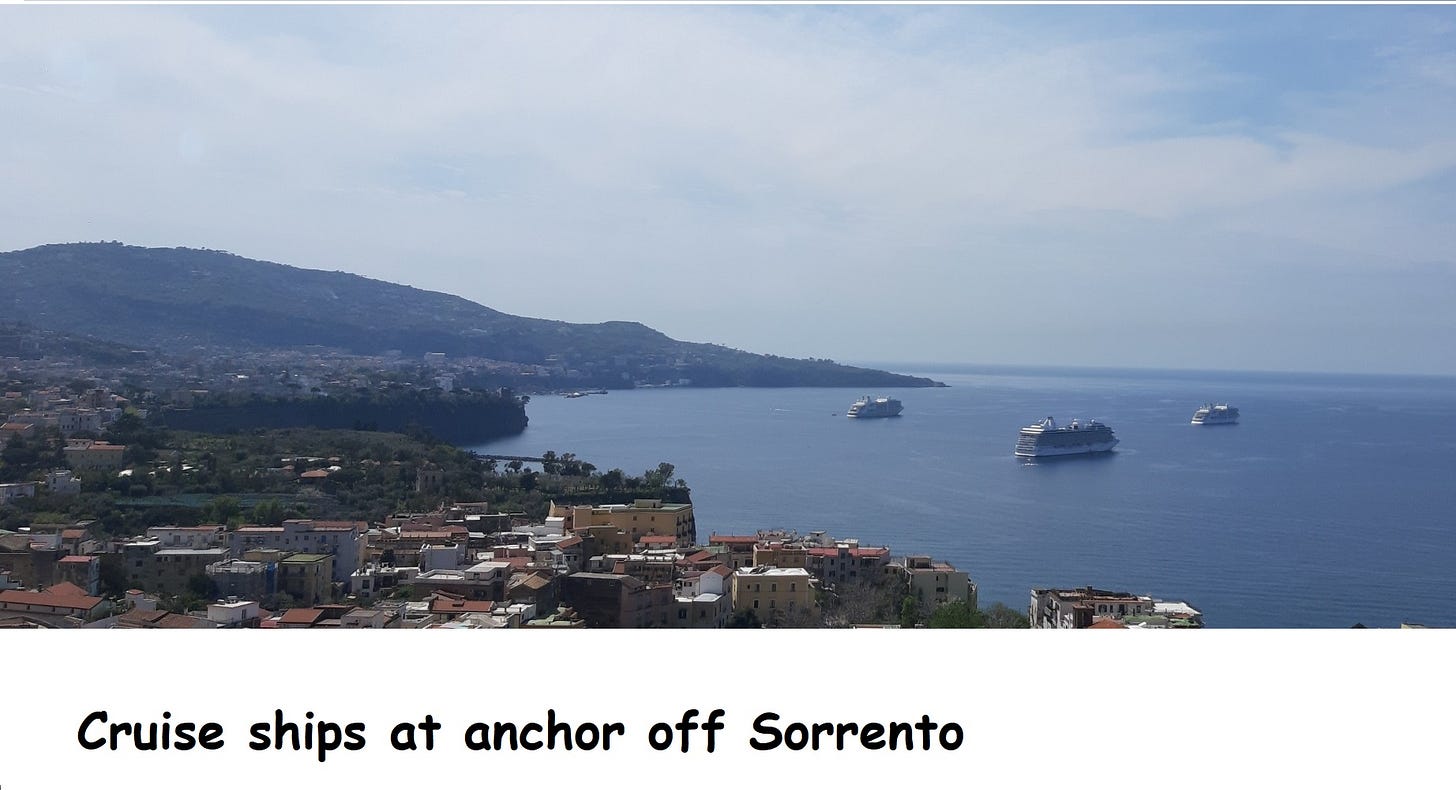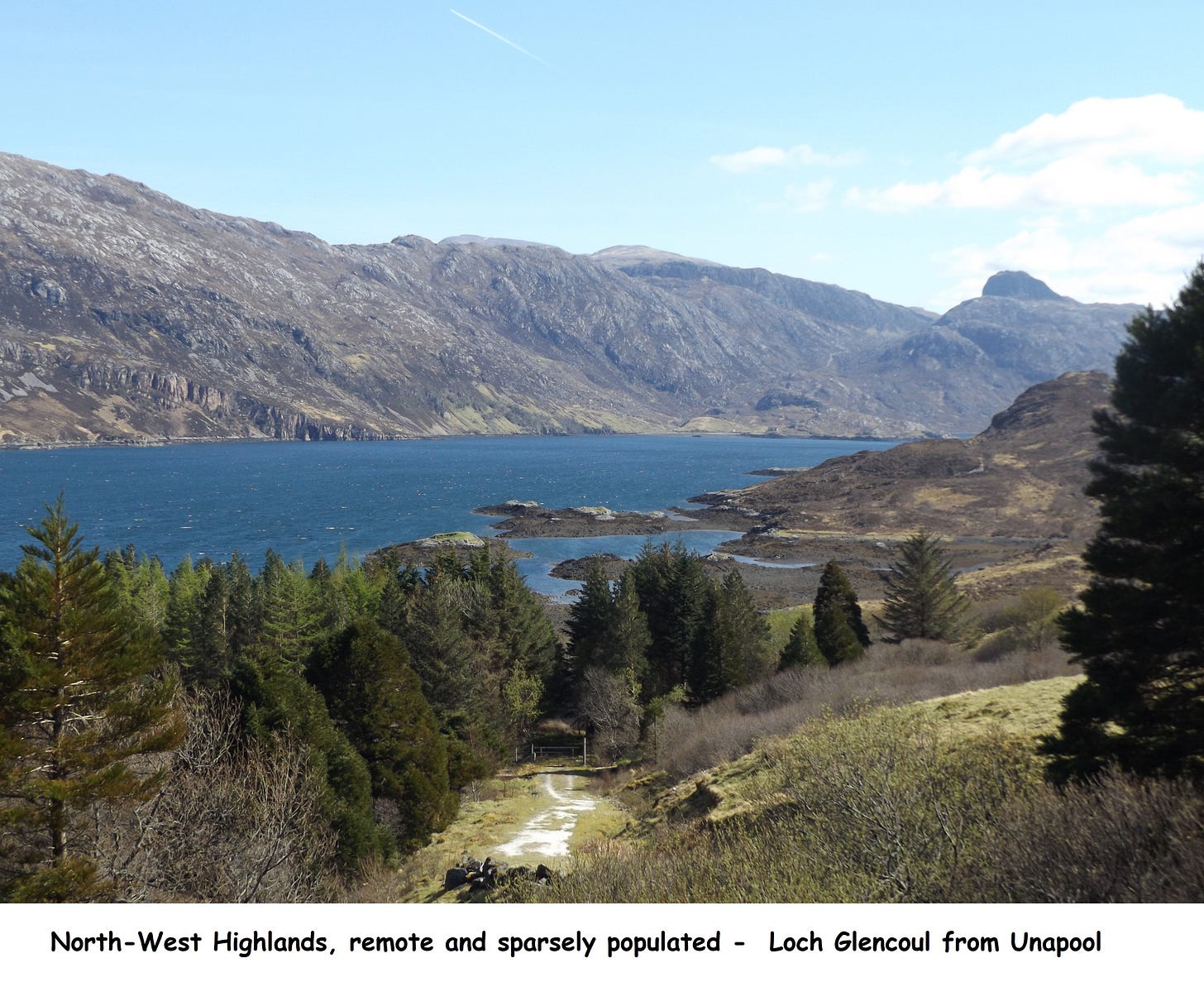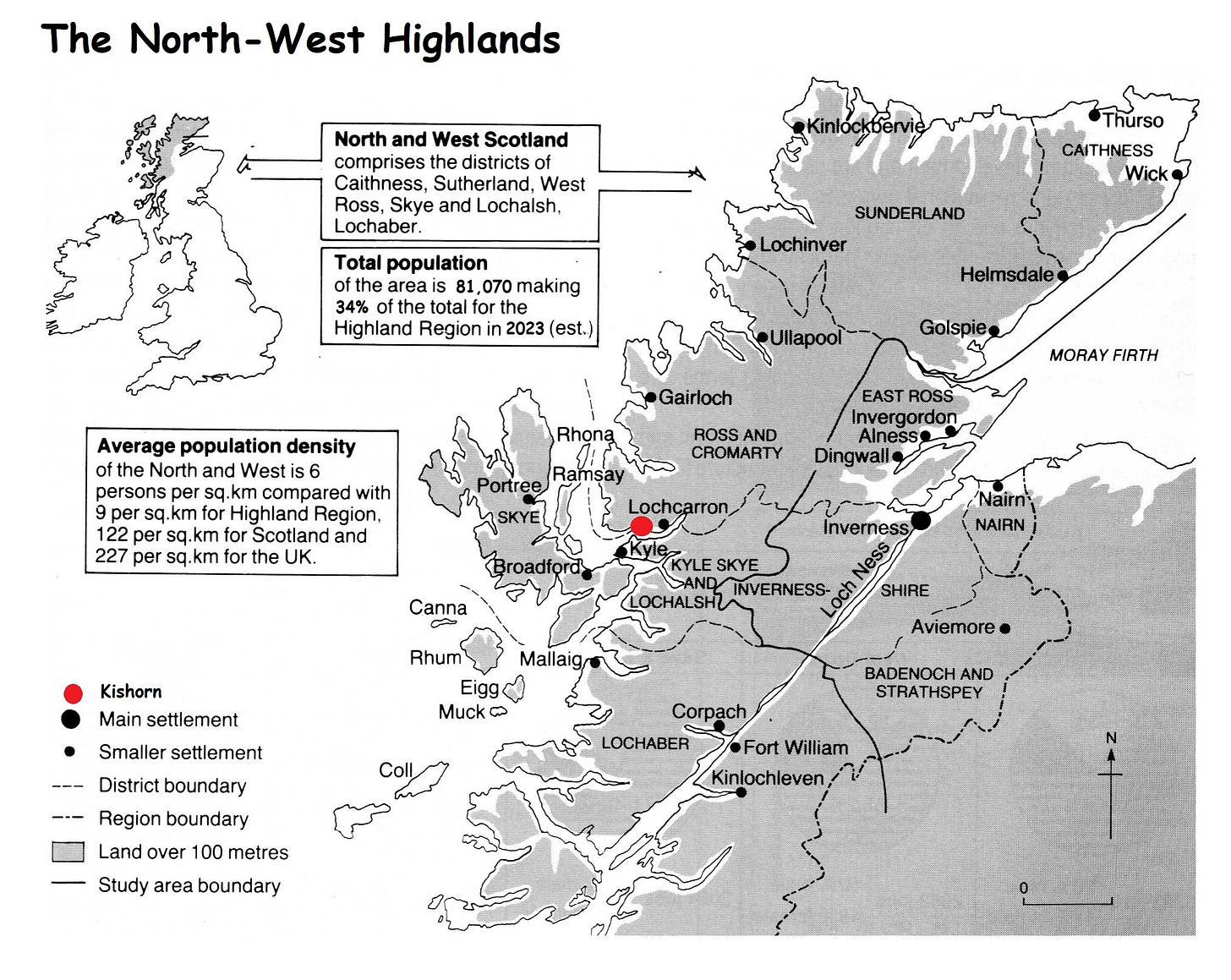Industrial Europe
According to available data, agriculture specifically accounted for approximately 4.2% of total employment across the European Union in 20204. However, this percentage varies significantly between countries, with Romania having 20.9% of its workforce employed in agriculture, Bulgaria 16.6%, Greece 9.7%, and Poland 9.0%. These figures demonstrate that despite overall industrialization across Europe, agriculture remains a significant employer in several Eastern and Southern European nations.
The Euro Core and periphery
In the context of European industrial development, the terms Euro Core and & Euro periphery are used to describe the regional disparities and economic differences within Europe. Let’s explore each concept in more detail:
1. Euro Core: The Euro Core refers to the more developed and industrialised regions of Europe. These regions are characterised by higher levels of economic prosperity, industrial output, and technological advancement. The Euro Core includes countries such as Germany, France, the Netherlands, Belgium, and parts of Scandinavia.
Industrial Strength: The Euro Core countries have a strong industrial base, with advanced manufacturing sectors. They are known for their production of automobiles, machinery, chemicals, precision instruments, and high-tech products. These industries benefit from skilled labour, robust infrastructure, research and development capabilities, and a supportive business environment.
Innovation and Technological Advancement: The Euro Core regions have a strong focus on innovation and technological advancement. They invest significantly in research and development, foster collaboration between academia and industry, and have established innovation clusters and technology parks. These efforts have led to the development of cutting-edge technologies and the growth of knowledge-intensive industries.
Infrastructure and Connectivity: The Euro Core regions have well-developed transportation networks, including highways, railways, and ports, facilitating efficient movement of goods and services. They are also characterized by advanced telecommunications infrastructure and digital connectivity, enabling seamless communication and integration within the European and global markets.
Skilled Workforce: The Euro Core regions benefit from a highly skilled and educated workforce. They have well-established educational institutions, vocational training programs, and a culture of continuous learning. This skilled labour pool contributes to the competitiveness and productivity of the industries in the Euro Core.
Economic Integration: The Euro Core countries have been at the forefront of European economic integration initiatives, such as the European Union and the Eurozone. This integration has facilitated the free movement of goods, capital, and labour, providing further opportunities for industrial development and collaboration within the Euro Core regions.
2. Euro Periphery: The Euro periphery refers to the less developed and economically weaker regions of Europe. These regions face various challenges in terms of industrial development, economic growth, and competitiveness. The Euro periphery includes countries such as Portugal, Spain, Greece, Eastern European countries, and certain regions within Italy.
Economic Disparities: The Euro periphery regions often experience lower levels of industrialisation and economic development compared to the Euro Core. They face challenges related to limited access to capital, infrastructure deficits, weaker institutional frameworks, and historical factors that hindered industrial growth.
Structural Transformation: Many Euro periphery regions have undergone a process of structural transformation, shifting from traditional industries to newer sectors such as tourism, services, and agriculture. While these sectors contribute to the local economy, they may not generate the same level of industrial output and technological advancements as the Euro Core regions.
EU Cohesion Policy: The European Union has implemented cohesion policies aimed a reducing regional disparities and supporting the development of the Euro periphery regions. These policies involve providing financial assistance, infrastructure investments, and capacity-building programs to promote economic growth and industrial development in these regions.
Labour Market Challenges: The Euro periphery regions often face challenges related to unemployment, brain drain, and a shortage of skilled labour. These issues can hinder industrial development and limit the ability of these regions to attract investment and foster technological advancements.
Regional Initiatives and Opportunities: Despite the challenges, there are regional initiatives and opportunities for industrial development within the Euro periphery. For example, Eastern European countries have experienced significant growth and attracted foreign direct investment due to their lower labour costs, skilled workforce, and proximity to expanding markets.
It is important to note that the concepts of Euro Core and Euro periphery are not fixed and can change over time.
Peripheral industrial regions of Europe - examples of Southern Italy and North West Scotland
Peripheral industrial regions in Europe, such as southern Italy and North West Scotland, are characterised by their relative distance from major economic centres and the challenges they face in terms of industrial development.
Southern Italy: Southern Italy, or the "Mezzogiorno," has long lagged behind the north in terms of economic development, employment, and living standards. This divide is one of the most pronounced regional disparities in Europe and is rooted in a combination of historical, economic, and institutional factors.
Economic Disparities and Key Statistics
GDP and Income: In 2022, the gross domestic product (GDP) of Northern Italy was €1,100 billion, compared to just €431 billion in the south. The GDP per capita in the southern regions is about half that of the north. Households in the north had an average disposable income of €24,000 in 2022, while southern families averaged only €16,000.
Employment: The employment rate starkly illustrates the divide. In 2023, the employment rate for people aged 20-64 was 79.6% in the northern province of Bolzano, but less than 50% in the southern regions of Campania, Calabria, and Sicily-the lowest rates in Europe. Unemployment in the south is more than 10 percentage points higher than in the north and 7 points above the national average.
Industrial Concentration: Northern Italy, particularly regions like Lombardy, has a GDP per capita at 127% of the EU average, while Calabria in the south is at just 56%. High-value manufacturing and industry are heavily concentrated in the north, while the south remains more dependent on agriculture and lower-productivity sectors.
Historical and Structural Causes
Industrialisation Patterns: The north-south divide deepened after World War II, as reductions in transportation costs and increased market integration favoured the north, which is closer to the rest of Europe and its markets. While some southern provinces were industrial centres in the early 20th century, by the 1970s, industry had become overwhelmingly concentrated in the north.
Institutional and Policy Factors: Post-unification public policies favoured northern regions, especially those bordering Austria and France, through greater investment in railways and public contracts. This gave the North a structural advantage in infrastructure and market access.
Quality of Institutions: The south lags in institutional quality, educational attainment, government efficiency, and bureaucratic effectiveness, which further hinders economic development and investment.
Social Consequences
Poverty and Welfare Dependence: Lower earnings and persistent unemployment have led to greater job insecurity and reliance on social welfare. In 2023, 876,000 households in the south received the Citizen’s Basic Income, compared to 283,000 in the north.
Informal Economy: The rate of irregular (informal) employment is much higher in the south (around 20%) than in the north (about 11%), contributing to lower tax revenues and weaker social protections4.Southern Italy, also known as Mezzogiorno, comprises the regions of Campania, Calabria, Apulia, Basilicata, Molise, and Sicily. It has historically been considered a peripheral industrial region due to its lower levels of economic development compared to the more prosperous northern regions of Italy.
Industrial Sectors: The industrial sectors in southern Italy are diverse but tend to be smaller in scale compared to the Euro Core regions. Agriculture, food processing, textiles, ceramics, and footwear are prominent industries. The region also has some specialised industries, including shipbuilding in Naples and the petrochemical industry in the Taranto area.
Initiatives for Development: Efforts have been made to promote industrial development in southern Italy. The government has implemented regional policies and received EU funding to support infrastructure development, entrepreneurship, and innovation. These initiatives aim to attract investment, improve competitiveness, and stimulate economic growth in the region.
Measures Taken to Reduce Economic Disparities Between Northern and Southern Italy
Cassa per il Mezzogiorno (1950s–1980s)
One of the earliest and most significant interventions was the creation of the Cassa per il Mezzogiorno, a state agency established in the 1950s. Its initial focus was on infrastructure and agricultural development in southern Italy. In the 1960s and early 1970s, the agency shifted toward providing industrial incentives, mainly targeting capital-intensive sectors. This period saw notable improvements in macroeconomic and social indicators for the south, and the gap with the north narrowed significantly during the agency's most effective years. However, by the mid-1970s, the effectiveness of the Cassa declined due to political pressures, misallocation of resources, and unproductive spending, ultimately leading to its dissolution.
European Union Cohesion Policy and Structural Funds
Italy has been a major beneficiary of the European Union’s Cohesion Policy, which aims to promote balanced and sustainable development across EU regions. Southern Italy has received substantial public investment, particularly in infrastructure, funded by European Structural and Investment Funds. Studies indicate that these funds have had a significant positive impact on per capita GDP in the south. However, their effect on closing the north-south gap has been less pronounced, partly because EU funds have sometimes replaced rather than supplemented national spending, and the region’s structural disadvantages persist.
Transition to Broader Regional Policies (1990s–Present)
From 1992 to 1998, Italy shifted from “extraordinary intervention” focused solely on the south to broader regional policies that also targeted other depressed areas. This transition was influenced by public finance challenges and political shifts, including the rise of the Lega Nord, which brought northern concerns to the forefront and reduced political consensus for southern-focused policies.
Fiscal Transfers and Social Welfare Measures
Inter-regional fiscal transfers have played a significant role, with public spending in the south exceeding local revenues. This has helped sustain income levels and public services, though it has not fully closed the economic gap. More recently, national policies such as the Citizen’s Basic Income (Reddito di Cittadinanza, 2019–2023) have aimed to support low-income families and promote employment in the south. In 2023, 876,000 southern households received this income support, compared to 283,000 in the north.
Labour Market and Public Employment Policies
Policies to equalise public sector wages across regions and create public employment in the south were intended to reduce migration and boost local economies. However, these measures sometimes led to inefficiencies, such as overstaffing, and did not resolve the underlying issues of unemployment and low productivity.
Over the decades, Italy has implemented a wide range of measures-from targeted state intervention and EU-funded projects to fiscal transfers and welfare policies-to reduce the economic divide between north and south. While these actions have supported incomes and improved infrastructure in the south, they have not fully overcome persistent structural disadvantages, and the regional gap remains substantial.
Tourism Potential: Southern Italy benefits from its rich cultural heritage, historical sites, and natural beauty, which make it a popular tourist destination. Tourism plays a significant role in the regional economy, contributing to job creation and generating income. The development of the tourism sector presents opportunities for complementary industries such as hospitality, transportation, and food services.
North West Scotland:
North West Scotland, included in the Highland Region, is another example of a peripheral industrial region in Europe. It faces challenges associated with its remote location, rugged terrain, and sparse population.
Geography and Infrastructure: The region’s geography, characterised by mountains, islands, and remote areas, poses challenges for infrastructure development and connectivity. Limited access to transportation networks, including roads and railways, can make it difficult for businesses to transport goods and access markets efficiently.
Traditional Industries: Historically, the region relied on traditional industries such as agriculture, fishing, forestry, and traditional crafts. These industries faced challenges due to changing economic dynamics, technological advancements, and the decline of certain sectors. However, efforts have been made to revitalise traditional industries and promote sustainable practices, such as organic farming and sustainable forestry.
Renewable Energy: North West Scotland has significant potential for renewable energy development. The region is rich in natural resources like wind, wave, and tidal energy. The growth of renewable energy projects, such as wind farms and hydroelectric power stations, presents opportunities for industrial development, job creation, and attracting investment to the region.
Creative and Cultural Industries: The North West Scotland region has witnessed the emergence of creative and cultural industries, including arts, crafts, design, and media. The natural beauty, cultural heritage, and creative talents in the region contribute to the growth of these industries. The creative sector offers opportunities for entrepreneurship, innovation, and cultural tourism.
Knowledge Economy and Research: The region has also focused on developing a knowledge- based economy. Efforts have been made to establish research and innovation centres, collaborate with universities, and promote knowledge transfer. These initiatives aim to attract businesses in sectors such as life sciences, digital technologies, and renewable energy research and development.
In conclusion, peripheral regions in Europe, like southern Italy and North West Scotland, face unique challenges and opportunities. Efforts to overcome these challenges involve initiatives to attract investment, improve infrastructure, support traditional industries, develop tourism and transport networks.
Kishorn, NW Scotland, an example of industrial change
Kishorn is an industrial area located in the North West Highlands of Scotland, specifically on the west coast of the Scottish Highlands. It serves as an example of industrial change and transformation.
1. Early Industrial Development: Kishorn’s industrial history dates back to the 1970s when it was chosen as the site for the construction of the Kishorn Dry Dock. The dry dock was designed to accommodate large-scale offshore oil rig construction and fabrication. The facility played a significant role in supporting the oil and gas industry in the North Sea during its boom years. At the time, Kishorn was one of the largest dry docks in Europe.
2. Decline and Transition: With the decline of the North Sea oil industry in the 1980s, Kishorn’s activities slowed down, leading to the closure of the dry dock. However, the area experienced a transition towards other industrial sectors and economic activities.
3. Renewable Energy Focus: In recent years, Kishorn has positioned itself as a hub for renewable energy development, particularly in the offshore wind sector. The expansive waters of the nearby North Atlantic Ocean make it an ideal location for wind energy projects. The area’s industrial infrastructure and strategic coastal position have attracted developers and companies involved in offshore wind farm construction and maintenance.
4. Port Revitalisation: Kishorn’s port facilities have been revitalised to support the growing renewable energy sector. The port has been upgraded to accommodate heavy-lift vessel operations, allowing for the transportation of large-scale wind turbine components and other equipment required for offshore wind projects. This revitalisation has led to increased economic activity and job creation in the area.
5. The Kishorn Yard: In recent years, efforts have been made to transform the former dry dock site into a multi-use industrial facility known as the Kishorn Yard. The site has been redeveloped and repurposed to cater to various industries, including renewable energy, decommissioning, and aquaculture. The Kishorn Yard offers infrastructure, laydown areas, and support services to companies involved in these sectors.
6. Job Creation and Local Benefits: The industrial transformation of Kishorn has brought new job opportunities to the local community and provided economic benefits to the widerregion. The development of renewable energy projects has created employment in construction, operation, and maintenance activities. Additionally, the influx of companies and contractors has generated secondary economic benefits for local businesses, hospitality, and service sectors.
7. Sustainability and Environmental Considerations: The focus on renewable energy and the decommissioning sector aligns with Scotland’s commitment to sustainability and reducing carbon emissions. Kishorn’s industrial change reflects the shift towards a greener and more sustainable industrial landscape.
Kishorn serves as an example of industrial change and adaptation. It has transitioned from its initial role in supporting the oil and gas industry to becoming a hub for renewable energy development, particularly in offshore wind. The revitalisation of port facilities and the establishment of the Kishorn Yard have supported job creation and local economic growth. This transformation highlights the region’s commitment to sustainable development and the utilisation of its natural resources for a greener future.
A similar transformation has taken place on the East coast of the Scottish Highlands at Ardersier port. Ardersier like Kishorn in the 1970’s and 80’s was a fabrication yard for North Sea oil platforms. Over the last two years, the port has been revitalised as a deep water port to import and assemble wind turbines for offshore wind projects. The port which is part of the Inverness and Cromarty Firth Green Freeport (ICFGF) consortium benefits from some financial incentives. Green Freeports are places where business can be carried out inside a country’s land border, but where the normal tax and customs rules don’t apply in full. They have boundaries agreed with both the UK government and the Scottish government.
They contain two types of sites where special rules apply, which can overlap. These are called ‘tax sites’ and ‘customs sites’. Companies can choose to locate themselves so that they profit from the benefits offered by one of these site types, or a combination of both.
Ardersier Energy Transition Facility - Haventus
Another reminder that industrial location is not a static concept and remoteness can be overcome by other advantages.
Geography Examination Questions
Short Answer Questions
What percentage of the European Union’s workforce was employed in agriculture in 2020, and which country had the highest proportion of agricultural employment?
Define the terms "Euro Core" and "Euro Periphery" in the context of European industrial development.
List three characteristics that distinguish Euro Core regions from Euro Periphery regions.
Name two countries typically considered part of the Euro Core and two considered part of the Euro Periphery.
Identify two main challenges faced by Euro Periphery regions in terms of industrial development.
Data Interpretation Questions
In 2022, what was the GDP of Northern Italy compared to Southern Italy? What does this suggest about regional economic disparities?
According to the text, what is the difference in average disposable household income between northern and southern Italy?
Structured/Essay Questions
Explain how historical and institutional factors have contributed to the economic divide between Northern and Southern Italy.
Discuss the main measures taken by the Italian government and the European Union to reduce economic disparities between northern and southern Italy. How effective have these measures been?
Describe the main industries in Southern Italy and explain why the region is considered a peripheral industrial region.
Assess the role of tourism in the economy of Southern Italy and identify two opportunities it creates for the region.
Case Study Questions
Outline the main geographical and infrastructural challenges faced by North West Scotland as a peripheral industrial region.
Discuss how North West Scotland is attempting to diversify its economy. Provide two examples from the text.
Examine the potential of renewable energy in North West Scotland and its significance for regional development.
Critical Thinking/Analysis Questions
Why might EU Cohesion Policy and Structural Funds have a limited impact on closing the north-south economic gap in Italy?
How does the concept of "brain drain" affect the labour market in Euro Periphery regions?
Evaluate the effectiveness of public employment policies in reducing regional disparities in Italy.
Multiple Choice Questions
Which of the following is NOT a typical feature of Euro Core regions?
A) High levels of industrial output
B) Advanced transportation networks
C) Heavy reliance on agriculture
D) Skilled and educated workforce
What is a major opportunity for industrial development in North West Scotland?
A) Expansion of heavy manufacturing
B) Growth of renewable energy projects
C) Large-scale car production
D) Decline in tourism
These questions cover factual recall, data interpretation, analysis, and critical thinking based on the provided text.






